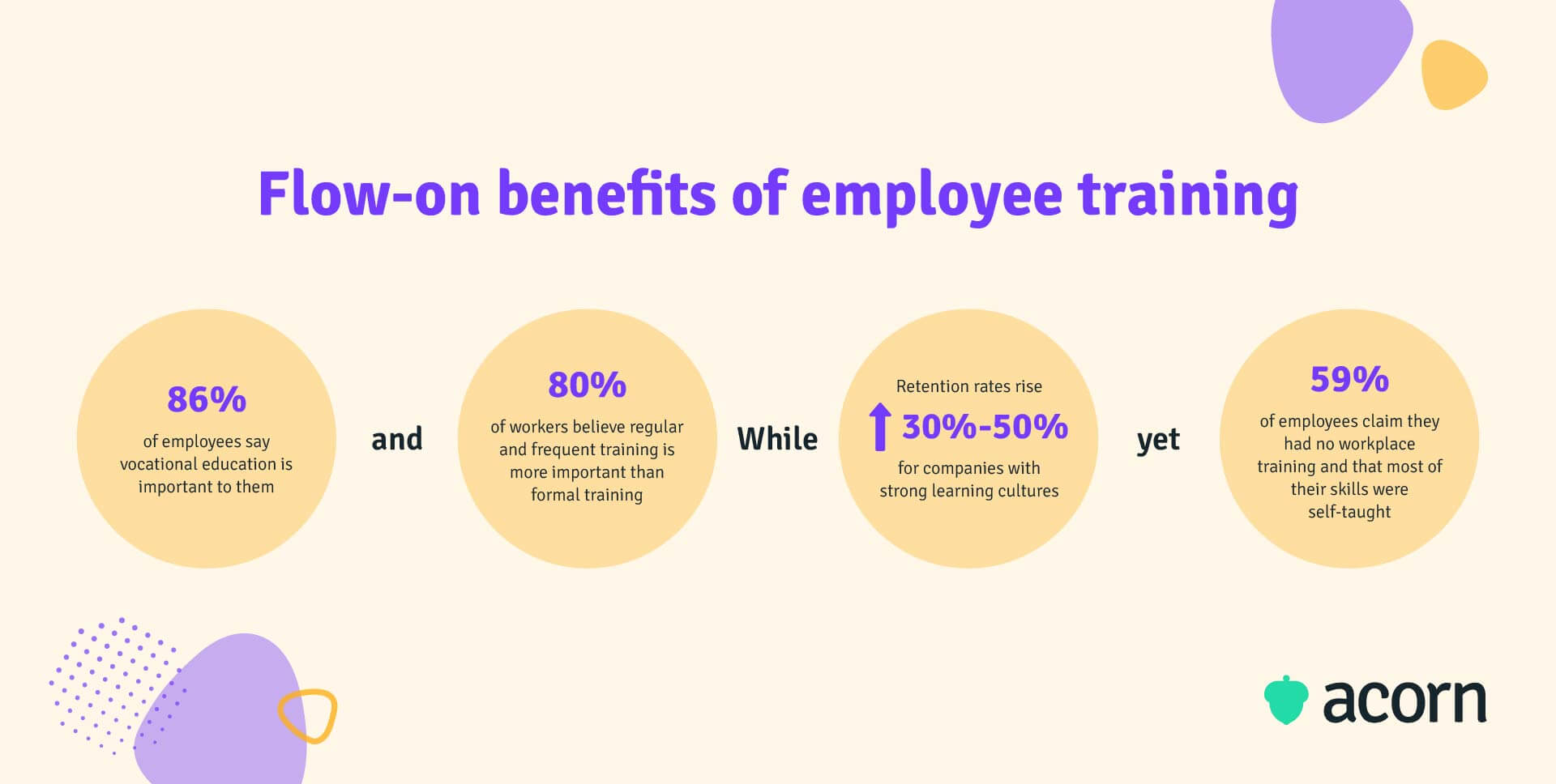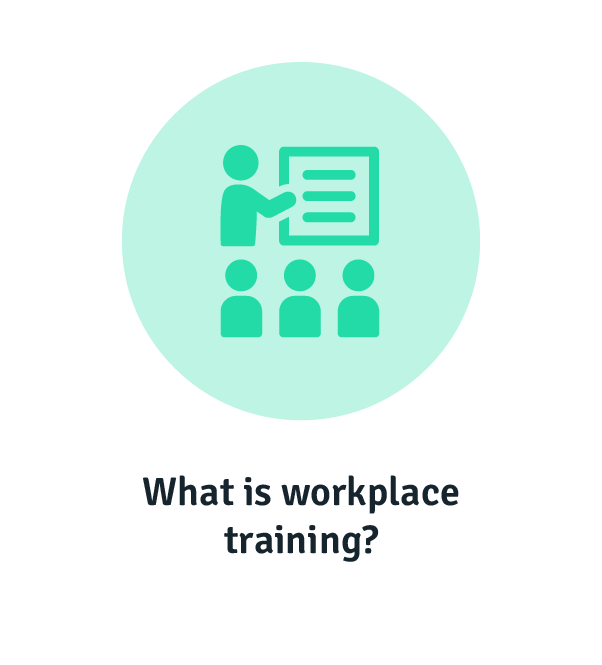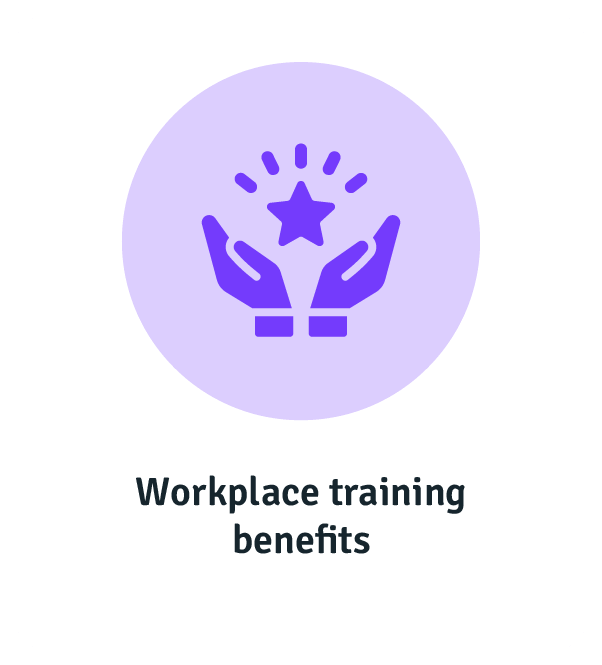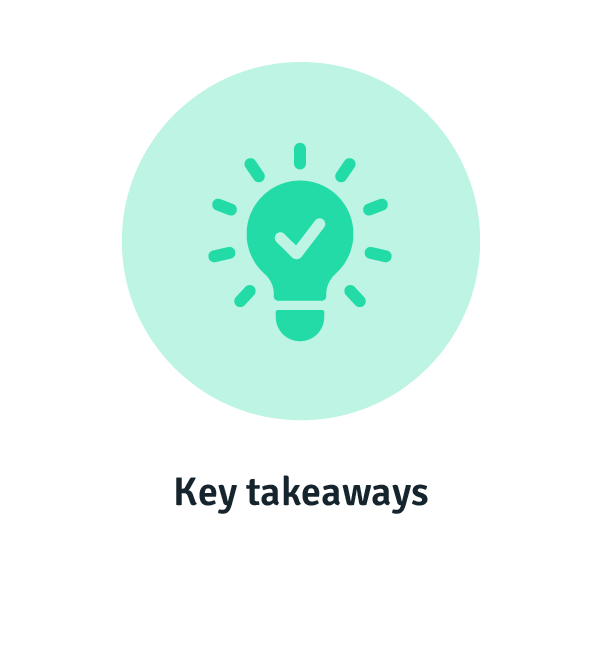The 5 Best Benefits of Employee Training and Development in the Workplace
Throughout an employee’s career, they’ll routinely encounter scenarios in which they need to adapt or upskill to succeed in a role. And for organisations, that means you need to be routinely providing training opportunities, lest you find yourself in a scenario where your workforce doesn’t have the skillsets to match the external rate of change.
However, workplace training and employee development has benefits beyond just upskilling your employees. It can improve employee engagement, attract top talent, and ultimately boost your bottom line.
Let’s dive in to why it’s so important to offer training to your staff, the real rewards you can expect to reap, and how to use an eLearning solution to train your workforce.
What is workplace training?
Workplace training is a structured learning program that provides employees with the knowledge, behaviours and experience needed to successfully perform their job roles. It can be provided as onboarding and orientation to help new hires acclimatise or through learning pathways for existing employees designed to create new skillsets.
Training for employee development in the workplace
The ideal employee comes ready-formed with the skillset, attitude and behaviour you need. They even evolve that skillset, attitude and behaviour as your organisation does, of their own initiative. They’re always innovating. They design industry-leading strategies. They drive your organisation’s unmarred success. Sounds nice, doesn’t it?
Well, we’d guess that winning the lottery and being set for life also sounds nice—and equally as unlikely, we’re sad to say. (No, really, winning the lottery sounds really nice.) It doesn’t matter if you’re a private enterprise, government department or small business. Proactive employee development in the workplace (and beyond) is a crucial business activity.
This needn’t be just a face-to-face initiative either; in fact, in a post-pandemic world, it’s clear that you need to offer flexible, digital and remote options. Consider eLearning platforms for one. These self-hosted or cloud-based solutions allow you to offer all the same kinds of education that you would firsthand (mentorships, secondments, instructor-led sessions) via a digital platform—so you’re not limited to your entire workforce physically being in the workplace.
Why it’s so important to offer training to your staff
Development opportunities are what those in the know call a win-win situation (great for building consensus). You don’t necessarily need to try and work out the unique meaning it has to you at this level, because it really comes down to maximising your investment.
For organisations
There are two big wins here:
- Continual employee development ensures you always have a highly skilled workforce, now and in the future.
- It’s your value proposition to both current and potential employees.
Having a unique proposition and a highly skilled workforce gives you an advantage on two fronts: Industry and job market.
Further, making learning and development (L&D) a standard company process goes a long way towards conveying the value you see in your employees. Most companies say they’re training employees, but very few actually walk the walk and provide meaningful development opportunities.
Many legacy learning management systems (LMSs) push an approach based on upskilling, but this is only part of the equation. And if you only focus on part of the equation, you’ll find training is simply not meaningful to employees, let alone impactful for your business.
This factored into our creation of the performance learning management system (PLMS). It starts on a foundation of organisational capabilities, guiding learners step-by-step through the specific capabilities they need to master for their role. Acorn PLMS also enables you to capture learning that is happening outside the system and transform them into shareable learning assets, so you’re codifying ways of work as they’re occurring.
This doesn’t even have to be about qualifications. News flash: Employees like milestone procedures (think annual reviews, end-of-probation check-ins, monthly chats) because they give them something to work towards. Attaching milestones such as promotions, widened internal opportunities or even secondments to the process makes it part of the employee lifecycle in your organisation, encouraging an uptick in engagement.
For employees
Most people will have experienced feeling a little out of their depth at some point in their careers. SurveyMonkey found that 86% of employees say vocational education is important to them, because it not only trains them to do better work but gives them more self-confidence.
Growth opportunities express to people that they are valued, whereas a lack of development options tells people they are not—even if that’s not what you intend. Employees who feel their organisations support them (and not just through platitudes or “elite opportunities” like output- and leadership-based awards that exclude the majority of the workforce) are more engaged, loyal and work harder for their employers.
Most employees can’t or don’t necessarily want to take on the financial burden of another qualification, which is where a workplace eLearning initiative is important. You can also remove the burden of content discovery off learners; by aligning courses with specific pathways in a workforce plan, for example, you exemplify the exact knowledge and experience individuals need. You may even be able to integrate your initiative with existing systems, too, like your collaboration tools, for further ease of access.
The real benefits of providing workplace employee training
The benefits of employee development read like a pipeline. No, really—you can map out an entire organisational talent pipeline and individual career trajectory through the benefits of workplace training. You’ll flow through:
- Improved productivity. Applying learned knowledge at the moment of need means your employees can more easily strategise, better understand their jobs and act as more effective team members.
- Increased employee engagement. Offering role enrichment, multi-directional careers and equal development opportunities helps build mental and emotional links with your organisation.
- The development of a better company culture. When you encourage your employees to be lifelong students, you improve team morale and onboarding practices.
- Better retention rates. Upskilling and reskilling helps you strengthen and retain top talent, giving you better internal mobility.
- A boost to your bottom line. Retaining top talent and creating better internal culture and processes directly leads to a better return on investment.

1. Improved productivity
With the right application of capabilities in the workplace, the most obvious and immediate advantage is improved employee performance. Those aforementioned interventions? Gives employees:
- The immediate information needed to bridge gaps in knowledge and work more effectually.
- A better understanding of their roles, which in turn imbues them with more confidence to work autonomously and take initiative.
- The hard (technical) and soft (interpersonal) skillsets needed to be effective team members (see point 4).
- Warrant to innovate and strategise. Creativity without fear of failure also helps employees learn in the flow of work.
- The right knowledge to adhere to quality and compliance standards, both your company’s and industry’s.
Basically, the potential touchpoints for heightened productivity ripple throughout the workplace.
2. Increased employee engagement
There are many definitions of employee engagement, but it boils down to an employee’s mental and emotional commitment to their organisation. Actively engaged employees are less likely to have accidents, take sick days and negatively impact their team members. They know what to do and importantly how to do it, going above and beyond. They’re pleasant to be around.
So, that previously mentioned internal mobility? Crucial for improving employee engagement. It demonstrates to employees that they have a future with your organisation; that they’re not just taking on a dead-end position for a couple of years for the resumé experience. Development improves and allows you to more easily assess employee engagement from a few angles:
- Role enrichment: One of the biggest drags on employee engagement in L&D is when the content is irrelevant or droll. Providing meaningful pathways for all employees helps to establish respect for the initiative and willingness to take on more study opportunities or duties.
- Multi-directional careers: The organisational hierarchy is flattening, which means employees’ careers can zig zag through different areas, teams and departments. By encouraging and enabling your employees to apply their talent where it makes most sense, you’ll create better engagement and productivity within the values and projects in each of your business areas.
- More informed managers: Don’t forget to engage your managers. Pathways for managers and employees alike helps your managers better bring out the best in their people. This also helps you build better teams, because your managers are best placed to inform your internal talent movements.
- Transparency: Make clear that one of the reasons for L&D is to support internal mobility and growth opportunities. Be sure to outline the criteria for internal movement beyond their education, but don’t miss the chance to show employees they have equal prospects.
3. Build a better culture
People take their cues from those around them. Think of your new hires. They’ll rely heavily on how their colleagues talk to one other, prioritise their work, take or don’t take initiative, the behaviours they exhibit. If they see others actively seeking out or completing study, they’ll take that as a regular workplace activity as much as the morning coffee run.
There’s also the little factor of working from home to consider. Company culture isn’t confined to the hallways. McKinsey found that an important part of the employee experience is purpose, which can be lost for those struggling with the disconnected nature of remote work. So, if company culture is the personality, behaviours and identity of your people combined, your organisation will struggle if your people aren’t happy and engaged. You can train people up on your company culture, but you’ll often find that L&D will help improve your culture, too.
- Set employee expectations: Let’s go back to the new hires. If, from day one, they see L&D programs as a regular part of the workplace, they’ll carry that notion throughout their tenure with you and, in turn, impart that knowledge onto future employees. You can also link to a dedicated website, like an onboarding portal, that helps educate employees on values, processes and procedures.
- Encourage a culture of lifelong learning: It’s an economic imperative to encourage continual study, says the Harvard Business Review. Where the luxury of learning (the growth-mindset most people have) is trumped by the urgency of work, you need to embed learning in the flow of work. Much of how we learn at work is incidental, so encourage it. Provide channels, such as a learning management system, for short-burst study like microlearning.
- Equal opportunities: Research has shown that employees with a lower level of education tend to participate less in training than those with higher education. This can create a sense of divide without attempts to bridge any gaps. However, the former often have a stronger intent to learn than the latter, which makes offering professional development and subsequent opportunities to all employees important.
- Boost team morale: 40% of employees who receive no or poor vocational education will leave a job within the year. Ongoing (cough, lifelong, cough) study helps employees feel confident in their knowledge and skillsets feel happier and more productive in their roles. When job satisfaction is higher, morale is boosted, and the culture within teams is more positive.
4. Retain top talent
Recruitment is an expensive zero-sum game. One empty role in Australia can cost up to $40,000 to fill. That’s a lot of money if that individual is then poached to another company because they didn’t find what they were looking for in your organisation, not to mention the productivity lag in between. And overall, this does nothing to address the gaps in knowledge your company is likely trying to fix tangentially.
“Skills gap” is the descriptor for a fundamental mismatch between the capabilities you as an employer need from your employees, and the skillsets those employees actually possess. Addressing the weaknesses or gaps in the skillsets in your organisation is key to a fruitful L&D initiative.
Look at upskilling and reskilling as changing gears. Sometimes external forces can impede recruitment efforts, so it becomes necessary to train employees in the latest capabilities relevant to or popular in your industry. In their 2019 Upskilling Matters report, Hays determined that the automation of repetitive tasks means employees need to perform higher value responsibilities. Additionally, Deloitte affirms the shelf-life of capabilities starts to expire at the five-year mark.
Either way, when you upskill or reskill employees, you create better internal mobility. It’s the new upward mobility, which focused on climbing that old school career ladder. Internal mobility is all about creating a more adaptable workforce that can dynamically move between roles at any level. This is a key recruitment and retention strategy because it gives employees the skillsets they want, while ensuring that you always have the talent you need internally—reducing the overheads on talent acquisition while you’re at it.
5. Boost your bottom line
Revenue is directly related to employee engagement, because the more engaged your employees are, the more productive and innovative they are, and the better your products or services you deliver and so forth. If you factor in the costs saved on retaining employees and lowering your recruitment costs (including marketing spend), you’ve already knocked out a budget that is likely out of pocket in an employee’s job market.
This is why it’s key to make links between your L&D objectives and business goals. If it’s to reduce HR spend, you might want to focus on creating pathways to upskill and reskill your current employees. Developing capabilities focused on behaviours—like adaptability and project management—could help you better face market changes. And in saying this, all the aforementioned benefits contribute to boosting your return on investment:
- Improved employee satisfaction lowers your turnover rates, saving on costs to recruitment and productivity.
- Higher productivity drives faster realisation of business goals and optimal use of resources.
- Engaged, educated employees need less supervision from their managers, freeing the latter up to focus on their responsibilities.

Different types of employee training programs for your workforce
A bit lost on where to start with implementing an L&D initiative? Let’s look at some of the different types of vocational education you can implement today:
- Onboarding
- Compliance
- Leadership
- Technical
- Soft skills
- Product
Onboarding
Onboarding is arguably the most important training you can provide. It sets up new hires with the information they need to be effective members of your organisation, while also setting the tone for company culture. Where onboarding can go wrong is when it’s neglected past the first week; it’s an ongoing progress that can and should last up to a year.
Why you need onboarding training
Onboarding portals are specific systems that new employees can access to search for resources such as employee handbooks, company information and introductions to their team. This helps assimilate and bring them up to speed quicker, and means leadership don’t have to micromanage.
Compliance
No industry goes without laws, regulations or standards that mandate business procedures. Even internally, your organisation may have processes that help to maintain workplace safety and prevent poor conduct. Examples of compliance training include workplace safety, diversity, anti-harassment and information security.
Why you need to train for compliance
At its heart, compliance is about minimising risk, providing a safe work environment for employees and, yes, maintaining your business reputation. It’ll help reduce legal problems for your organisation as well, and regular compliance training ensures your employees are up to date on any changes year to year.
Leadership
In the case an employee asks for a promotion or is spotlighted as having potential, you’ll need tailored courses to upskill them. Having pre-determined pathways for succession planning will help you fast-track an internal talent pipeline, as well, and allows employees to see the path for progression where they may not be able to contact a mentor for career advice. Consider blended programs here, such as an online people management or conflict resolution course combined with job shadowing.
Why you need to train leaders
Even those with the best potential can’t necessarily step into a role ready-made for the responsibilities. Going from managing only your own emotional baggage as an individual contributor to an entire team as a line manager can be an unexpected hurdle L&D can mitigate. Proactively developing leadership amongst employees also helps motivate them and provides channels for better feedback, as well as manage the type of leadership styles you want in your organisation.
Technical
Technical training teaches employees the expertise needed to design, maintain and/or operate certain technologies or applications. This is the main way your employees know how to technically perform their jobs right, and with technical knowledge, there is always room for improvement.
Why you need to train for technical expertise
Technology moves fast, which means your employees need to be up to date to keep your business moving at the same pace of change. The largest cohort in your workforce, Millennials, were being born when floppy disks were still a thing. We’ve since jumped to phones that fit in our pockets and artificial intelligence that can write code. But technical training is not just related to technology: Content writing, social media management and data analysis are all crucial capabilities that are crucial to new age business success.
Soft skills
Here, we’re talking about interpersonal relationships and communication. They’re crucial to driving your culture and long-term success because these elements come down to emotional intelligence, not technical knowledge. Service industries are where these are most needed, but all organisations will find developing emotional intelligence beneficial. It’s all about enabling your employees to work respectfully with one another and your customers.
Why you need to train for soft skills
Capabilities you can train for here include:
- Accountability and ownership
- Emotional intelligence
- Ethics
- Time management
These are all important for creating respectful, effective team players. And like we discussed earlier, a better team culture creates more engaged employees, and more engaged employees are more productive. Win-win.
Product
Product training is often utilised by sales personnel to ensure they’re up to date on the features and benefits of new products. However, it can also be helpful for departments like marketing in order to deliver informed brand messaging—which is why it’s important to create different programs for different audiences.
Why you need product training
When departments work independently of one another, it can be easy for different interpretations of products to arise. When talking with customers, it’s important for any employees to have sound product knowledge in order to answer difficult questions, tailor products to a customer and build trust with your customers.
Key takeaways
Workplace employee training is important for creating a workforce that will help you achieve business goals now and in the future. By offering pathways for development, you make your organisation more attractive to potential employees while keeping existing employees loyal to your value proposition.
The benefits of workplace training stack up over time. Offering equal study opportunities gives your organisation the following advantages:
- Employees’ productivity, autonomy and ability to innovate improve
- Employee engagement in business goals increases
- Team and company culture improves
- Recruitment costs go down as you retain top talent better
- You have better internal mobility as you create the skillsets you need
- Your bottom line is boosted.
Employee development is not one-size-fits-all; it can look different depending on the programs you deem necessary. Training for interpersonal relationships and communication, technical expertise, leadership, onboarding, compliance and product knowledge are just some of the avenues that can help you reap the rewards of employee development.
Related Reads on This Topic

The Importance of Retaining the High-Potential Employee (aka the HiPo)
Retaining high-potential employees (HiPo) is highly important for any business. Find out why and how your company can achieve this…

Why You Should Use a Leadership Capability Framework When Developing Leaders
A leadership capability framework is designed to outline the skills, knowledge, and abilities required to perform a leadership role…

What is Succession Planning and Why Is It Important for Business Strategy?
Succession planning can play a major role in ensuring productivity and workforce planning. Find out more about it and why it’s important…




